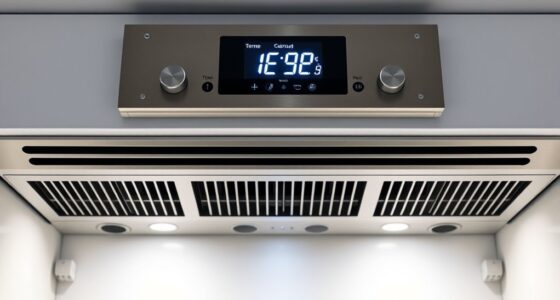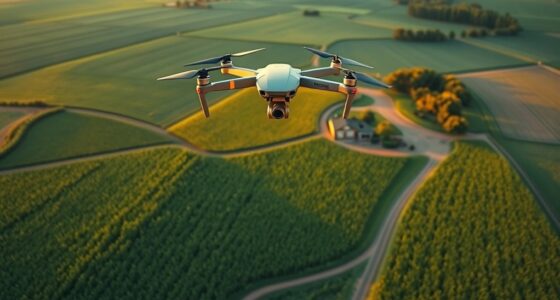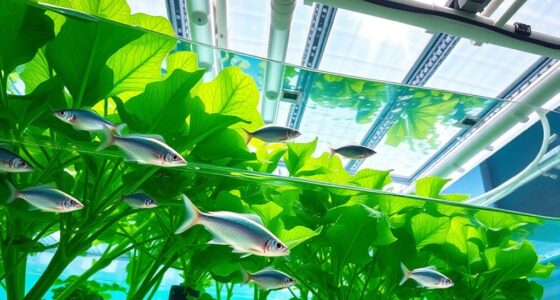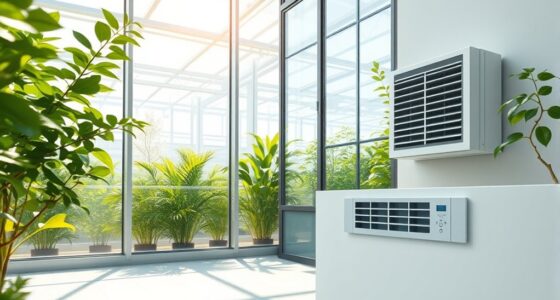LED lighting breakthroughs now let you customize light spectra specifically for your plants’ needs, boosting growth and health. By matching LEDs to photosynthesis requirements, you waste less energy and see better flowering and foliage. These lights are energy-efficient, last longer, and generate less heat, saving you money and reducing your environmental impact. With such advanced options, your indoor garden can thrive like never before—discover how these innovations can transform your plant care journey.
Key Takeaways
- Spectral optimization tailors LED light to match plant photosynthetic needs, boosting growth and flowering.
- Targeted wavelengths improve photosynthesis efficiency and plant health compared to broad-spectrum lighting.
- Modern LEDs offer high energy efficiency, lower power consumption, and reduced heat output, saving costs.
- Long-lasting LEDs reduce replacement frequency, ensuring sustainable and cost-effective indoor gardening.
- Customizable spectral output supports diverse plant types, enabling precise control for optimal indoor growth conditions.

Recent breakthroughs in LED lighting are revolutionizing the way we illuminate our homes and workplaces. Now, these advances are also transforming the way you care for your plants, especially through spectral optimization and energy efficiency. By tailoring the light spectrum emitted from LEDs, manufacturers are creating solutions that cater specifically to plant growth needs, allowing you to foster healthier, more vibrant plants indoors. Spectral optimization involves fine-tuning the light’s wavelengths to match the photosynthetic requirements of different plant species, ensuring they receive the precise light spectrum needed to thrive. This means you no longer have to rely on broad-spectrum lights that waste energy illuminating unnecessary wavelengths. Instead, you can provide your plants with targeted lighting that boosts photosynthesis, encourages better flowering, and promotes stronger foliage. As a result, your indoor gardening efforts become more effective and efficient, reducing waste and maximizing growth.
Energy efficiency is at the core of these LED innovations, meaning you can enjoy significant savings on electricity bills while supporting your green thumb ambitions. Modern LEDs consume far less power than traditional grow lights but produce comparable or even superior light quality. This efficiency ensures that your plants receive consistent, high-quality illumination without draining your energy resources. Plus, LEDs generate less heat, reducing the risk of heat damage and the need for additional cooling systems—saving you even more money in the long run. With these energy-efficient LEDs, you have the ability to extend light exposure hours without increasing your energy costs, creating ideal conditions for your plants to flourish.
Another benefit of these breakthroughs is the longevity of LED lights. Unlike older lighting technologies, LEDs last for tens of thousands of hours, meaning you won’t need frequent replacements. This durability makes them a cost-effective choice over time, especially considering the enhanced spectral customization they now offer. As you choose LED grow lights with spectral optimization and high energy efficiency, you’re investing in a sustainable, eco-friendly solution that aligns with modern environmental goals. This not only benefits your plants but also reduces your carbon footprint. Whether you’re cultivating herbs, flowering plants, or vegetables indoors, these innovative LED lights allow you to control the light spectrum precisely, fostering ideal growth conditions.
Frequently Asked Questions
How Do LED Grow Lights Compare to Traditional Grow Lights?
You’ll find that LED grow lights outperform traditional grow lights in many ways. They offer superior spectral quality, providing the specific wavelengths your plants need for healthy growth. Plus, LED lights deliver higher light intensity efficiently, meaning your plants get more energy without wasting electricity. Unlike traditional options, LEDs also generate less heat, making temperature control easier. Overall, LEDs give you better control and results for your gardening success.
What Are the Energy Savings of New LED Lighting Technology?
You’ll find that new LED lighting technology offers impressive energy efficiency, meaning you use less power for the same or better light output. This results in significant cost savings on your electricity bills over time. Advanced LEDs emit less heat and consume less energy, making your setup more sustainable and economical. Overall, upgrading to modern LED lights helps you save money while providing ideal lighting conditions for your plants.
Can LED Lights Be Customized for Different Plant Growth Stages?
Yes, LED lights can be customized for different plant growth stages through spectral tuning. You can adjust the light spectrum to meet the specific needs of seedlings, vegetative, or flowering phases, ensuring ideal growth. By tailoring the spectral output, you give your plants the precise light they need at each stage, boosting health and yield. This flexibility makes LED lighting a powerful tool for maximizing plant development effectively.
Are There Any Health Risks Associated With LED Grow Lights?
You might wonder if LED grow lights pose health risks. While they emit UV exposure and blue light hazards, proper usage minimizes these dangers. Avoid staring directly at the lights for extended periods, and make certain your grow area is well-ventilated. Manufacturers design these lights with safety features, but it is crucial to follow guidelines. With proper precautions, you can enjoy the benefits without worrying about UV exposure or blue light hazards.
How Long Do Advanced LED Grow Lights Typically Last?
While advanced LED grow lights boast impressive light fixture durability, their lifespan varies widely. Typically, you can expect these lights to last between 50,000 to 100,000 hours of use, translating to several years depending on daily operation. This means fewer replacement intervals and less hassle, but it is crucial to monitor performance over time since even durable fixtures may eventually dim or degrade, signaling it’s time for a replacement.
Conclusion
With these LED lighting breakthroughs, you can optimize your plant growth like never before. Recent studies suggest that tailored light spectrums can markedly boost photosynthesis and yield, challenging the old belief that all light is equally beneficial. As technology advances, it’s likely that future innovations will further enhance plant health and productivity. Embrace these innovations confidently, knowing that scientific research supports their effectiveness—and your plants will thank you for it.










